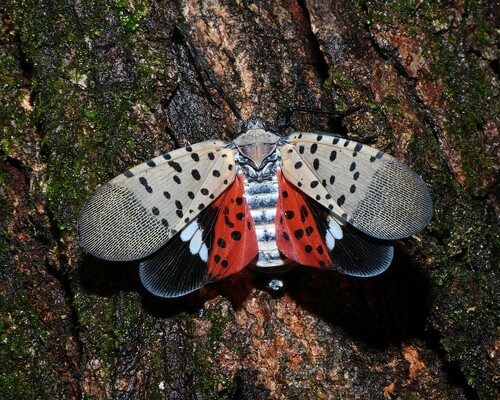By Laura Warman, Grants Manager

You might remember hearing about spotted lanternflies (SLF, Lycorma delicatula) in the news (or on this blog!) last year. These planthoppers feed on the sap of many species of plants and can have very negative effects both on crops and natural systems. Not only is their feeding detrimental to their host plants, and particularly to plants like grapes, but they excrete a honeydew-like sugary liquid (similar to aphids) that attracts other insects and also serves as a growing medium for sooty mold – both on plants and human structures.
SLF has continued to spread in the US since first being found in Pennsylvania in 2014, and today has been found across 14 states along the east coast. Unfortunately, SLF may be gaining more of a toehold in North Carolina and individuals have been found in 15 counties, with infestations confirmed in Guilford and Forsyth counties. Trees of heaven (Ailanthus altissima), another invasive, are one of SLFs preferred hosts and may be paving the way for their expansion in the Eastern US. Egg masses start to hatch in May, and both juvenile and adult SLFs can be found in early summer.

Keep in mind there are quite a few lookalikes, but if you find something you think might be a spotted lanternfly, please take a photo and report it to the NC Department of Agriculture and Consumer Services using this form, or email it to badbug@ncagr.gov. In addition to reporting, always destroy SLF egg-masses if you can find them and remove trees of heaven – which are a bad invasive even without their link to SLFs.
TLC Stewardship staff and volunteers work hard to remove invasive plants from our nature preserves, including SLF’s favorite host, the tree of heaven. If you are interested in assisting our efforts to protect native habitats and species from this threat (and others!), be sure to check out our volunteer website for opportunities across the Triangle.
